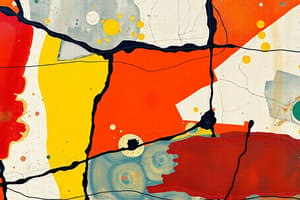Podcast
Questions and Answers
Which part of the gastrointestinal tract is responsible for the absorption of iron?
Which part of the gastrointestinal tract is responsible for the absorption of iron?
- Esophagus and stomach
- Ileum and colon
- Duodenum and jejunum (correct)
- Rectum and anus
What is the effect of reducing substances in the diet on iron absorption?
What is the effect of reducing substances in the diet on iron absorption?
- No effect on iron absorption
- Decrease iron absorption
- Turns iron into a different element
- Increase iron absorption (correct)
How does copper affect the absorption of iron in the body?
How does copper affect the absorption of iron in the body?
- Copper helps in iron absorption (correct)
- Copper converts iron to a toxic state
- Copper decreases iron absorption
- Copper has no impact on iron absorption
What makes iron from animal tissues more absorbable than that from plant origin?
What makes iron from animal tissues more absorbable than that from plant origin?
Which trace element is rapidly absorbed in the ferrous state after entering the blood?
Which trace element is rapidly absorbed in the ferrous state after entering the blood?
What helps convert ferric iron to the more absorbable ferrous state in the diet?
What helps convert ferric iron to the more absorbable ferrous state in the diet?
Which part of the gastrointestinal tract plays a crucial role in iron absorption?
Which part of the gastrointestinal tract plays a crucial role in iron absorption?
What percentage of dietary iron is typically absorbed on an average diet?
What percentage of dietary iron is typically absorbed on an average diet?
Which factor reduces the absorption of iron by decreasing its solubility?
Which factor reduces the absorption of iron by decreasing its solubility?
What catalyzes the oxidation of ferrous iron to ferric iron in the blood plasma?
What catalyzes the oxidation of ferrous iron to ferric iron in the blood plasma?
Which is NOT a source of iron according to the text?
Which is NOT a source of iron according to the text?
Iron absorption mainly occurs in the large intestine.
Iron absorption mainly occurs in the large intestine.
Iron is considered a trace element because it is required in quantities less than 100mg per day.
Iron is considered a trace element because it is required in quantities less than 100mg per day.
Copper plays a role in catalyzing the oxidation of ferrous iron to ferric iron in the blood plasma.
Copper plays a role in catalyzing the oxidation of ferrous iron to ferric iron in the blood plasma.
High pH enhances the solubility of iron, thereby increasing its absorption.
High pH enhances the solubility of iron, thereby increasing its absorption.
Iron from plant sources is more absorbable than iron from animal tissues due to their solubility.
Iron from plant sources is more absorbable than iron from animal tissues due to their solubility.
Molasses and legumes are not considered good sources of iron in the diet.
Molasses and legumes are not considered good sources of iron in the diet.
The absorption of iron is not affected by the state of iron present in dietary sources.
The absorption of iron is not affected by the state of iron present in dietary sources.
Iron absorption decreases when there is an excess of phosphate in the diet.
Iron absorption decreases when there is an excess of phosphate in the diet.
Iron is carried by hemoglobin in the blood plasma before being oxidized to the ferric state.
Iron is carried by hemoglobin in the blood plasma before being oxidized to the ferric state.
The absorption of iron from animal tissues is less efficient compared to that from plant sources.
The absorption of iron from animal tissues is less efficient compared to that from plant sources.
Flashcards are hidden until you start studying
Study Notes
Iron Absorption in the Gastrointestinal Tract
- Iron absorption primarily occurs in the duodenum, the first section of the small intestine.
- On average, 10-15% of dietary iron is absorbed.
- Iron from animal tissues is more absorbable than that from plant sources due to its heme form, which is better utilized.
Dietary Influences on Iron Absorption
- Reducing substances such as ascorbic acid (vitamin C) enhance iron absorption by converting ferric iron to a more absorbable ferrous state.
- High phosphate levels in the diet can inhibit iron absorption by decreasing its solubility.
- Copper aids in iron absorption by catalyzing the oxidation of ferrous iron to ferric iron in blood plasma.
Misconceptions about Iron Sources
- Molasses and legumes are not considered good sources of iron despite some beliefs.
- Iron is indeed a trace element, required in quantities less than 100mg per day.
Factors Affecting Iron States
- High pH environments reduce iron solubility, negatively affecting absorption.
- Ferrous iron, when it enters the blood, is rapidly absorbed and transported before conversion to ferric iron.
Summary of Absorption Dynamics
- Iron absorption is significantly influenced by food composition, the presence of enhancing or inhibiting substances, and the form of iron consumed.
Studying That Suits You
Use AI to generate personalized quizzes and flashcards to suit your learning preferences.




